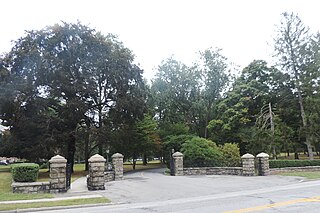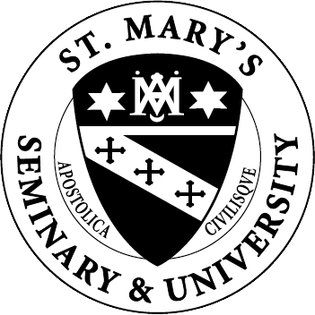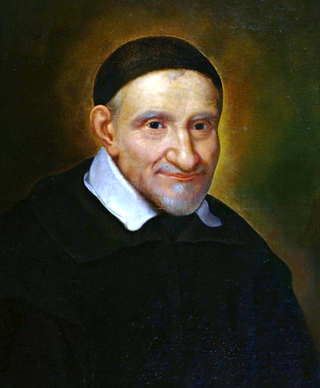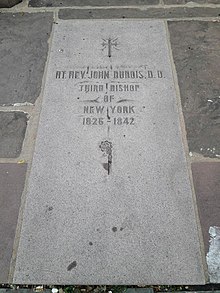
Elizabeth Ann Bayley Seton was a Catholic religious sister in the United States and an educator, known as a founder of the country's parochial school system. After her death, she became the first person born in what would become the United States to be canonized by the Catholic Church. She also established the first Catholic girls' school in the nation in Emmitsburg, Maryland, where she likewise founded the first American congregation of religious sisters, the Sisters of Charity.

The Metropolitan Archdiocese of Baltimore is the archdiocese of the Latin Church of the Catholic Church in northern and western Maryland in the United States. It is the metropolitan see of the Ecclesiastical Province of Baltimore.

John Baptist Purcell was an American prelate of the Catholic Church. He served as Bishop of Cincinnati from 1833 to his death in 1883, and he was elevated to the rank of archbishop in 1850. He formed the basis of Father Ferrand, the Ohio-based "Irish by birth, French by ancestry" character in the prologue of Willa Cather's historical novel Death Comes for the Archbishop who goes to Rome asking for a bishop for New Mexico Territory.

Mount St. Mary's University is a private Roman Catholic university in Emmitsburg, Maryland. It has the largest Catholic seminary in the United States. Undergraduate programs are divided between the College of Liberal Arts, the Richard J. Bolte School of Business, and the School of Natural Science and Mathematics. "The Mount" has over 40 undergraduate majors, minors, concentrations, and special programs, as well as bachelor's/master's combinations in partnership with other universities, 8 master's programs, and 6 postgraduate certificate programs.
The Society of Priests of Saint-Sulpice, also known as the Sulpicians, is a society of apostolic life of Pontifical Right for men, named after the Church of Saint-Sulpice, Paris, where it was founded. The members of the Society add the nominal letters PSS after their names to indicate membership in the Congregation. Typically, priests become members of the Society of the Priests of St. Sulpice only after ordination and some years of pastoral work. The purpose of the society is mainly the education of priests and to some extent parish work. As their main role is the education of those preparing to become priests, Sulpicians place great emphasis on the academic and spiritual formation of their own members, who commit themselves to undergoing lifelong development in these areas. The Society is divided into three provinces, operating in various countries: the Province of France, Canada, and the United States.

St. Joseph's Seminary and College, sometimes referred to as Dunwoodie after the Dunwoodie neighborhood of Yonkers, New York in which it is located, is the major seminary of the Archdiocese of New York. Since 2012, it has also been the major seminary for the Diocese of Brooklyn and the Diocese of Rockville Centre.

Louis William Valentine DuBourg was a French Catholic prelate and Sulpician missionary to the United States. He built up the church in the vast new Louisiana Territory as the Bishop of Louisiana and the Two Floridas and later became the Bishop of Montauban and finally the Archbishop of Besançon in France.

St. Mary's Seminary and University is a Catholic seminary located within the Archdiocese of Baltimore in Baltimore, Maryland; it was the first seminary founded in the United States after the Revolution and has been run since its founding by the Society of the Priests of Saint Sulpice.

The Sisters of Charity Federation in the Vincentian-Setonian Tradition is an organization of fourteen congregations of religious women in the Catholic Church who trace their lineage to Saint Elizabeth Seton, Saint Vincent de Paul, and Saint Louise de Marillac.
David William Bacon was an American prelate of the Roman Catholic Church. He served as the first bishop of the Diocese of Portland in Maine and New Hampshire from 1855 until his death in 1874.

Ambrose Maréchal, P.S.S. was a French-born Sulpician priest and prelate of the Roman Catholic Church who served as the third archbishop of the Archdiocese of Baltimore in Maryland.

James Whitfield was an English-born prelate of the Roman Catholic Church in the United States. He served as archbishop of the Archdiocese of Baltimore in Maryland from 1828 until his death in 1834.

Samuel Eccleston, P.S.S. was an American prelate of the Roman Catholic Church who served as the fifth Archbishop of the Archdiocese of Baltimore, Maryland from 1834 until his death in 1851.

John Mary Joseph Benedict Chanche, S.S., was an American prelate of the Roman Catholic Church. He served as the first bishop Diocese of Natchez in Mississippi from 1841 to 1852.

Seton Hill Historic District is a historic district in Baltimore, Maryland. It was listed on the National Register of Historic Places in 1975.

The National Shrine of Saint Elizabeth Ann Seton is a U.S. religious site and educational center in Emmitsburg, Maryland, that pays tribute to the life and mission of Elizabeth Ann Seton, the first native-born citizen of the United States to be canonized by the Roman Catholic Church. It is both a minor basilica and a national shrine.

John Carroll was an American prelate of the Catholic Church who served as the first bishop of the Diocese of Baltimore, the first diocese in the new United States. He later became the first archbishop of Baltimore. Until 1808, Carroll administered the entire American Catholic Church.
Catherine Josephine Seton was the daughter of Elizabeth Ann Seton, founder of the American branch of the Sisters of Charity. Catherine was the first American to join the Irish Sisters of Mercy.
John Tessier S.S. was a French Sulpician priest who emigrated from France at the time of the Revolution. From 1810 to 1829 he was the Provincial Superior of the Sulpician congregation in the United States. He served as vicar-general to the Roman Catholic Bishops of Baltimore, and for a time oversaw both St. Mary's Seminary in Baltimore and Mount St. Mary's College and Seminary in Emmitsburg, Maryland.
The history of the French in Baltimore dates back to the 18th century. The earliest wave of French immigration began in the mid-18th century, bringing many Acadian refugees from Canada's Maritime Provinces. The Acadians were exiled from Canada by the British during the French and Indian War. Later waves of French settlement in Baltimore from the 1790s to the early 19th century brought Roman Catholic refugees of the French Revolution and refugees of the Haitian Revolution from the French colony of Saint-Domingue.


















